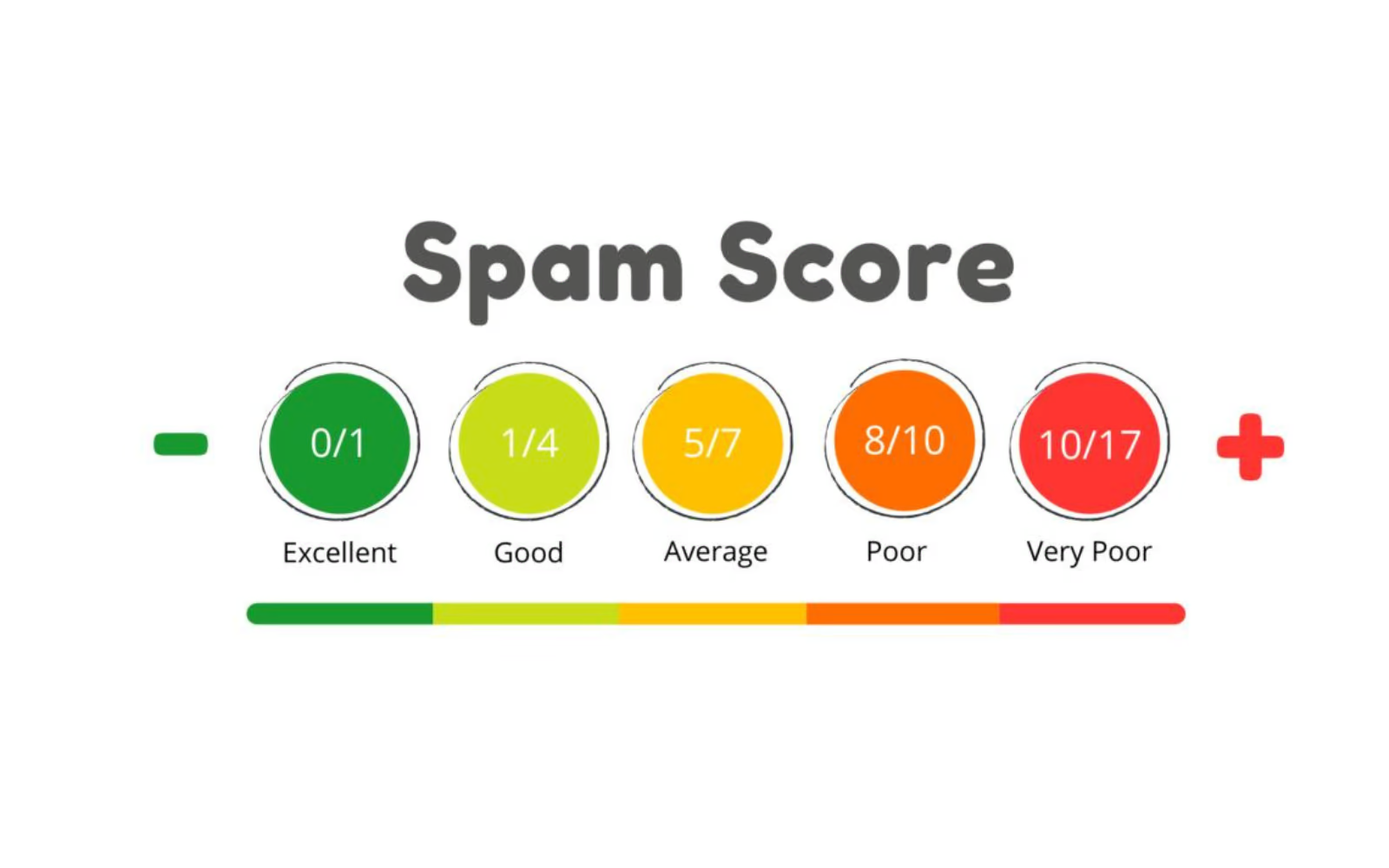To succeed in email marketing, your emails must be delivered and read correctly. But what if your email goes to the spam folder? This is where a spam score-checking tool can come in handy. In this blog post, we will understand what spam score checkers are, how they work, and why they are essential to your email marketing strategy.
What Are Spam Score Checkers?
Spam score checkers are tools that analyze your email marketing content and tell you how likely your email is to go to the spam folder. When you send an email, it is important that your message lands in your recipient’s inbox and not the spam folder. Spam score checkers evaluate the content, structure, and other aspects of your email to predict whether or not a spam filter will flag your email.
What Are Spam Score Checkers?
Spam score checkers are tools or software that analyze the content of an email to estimate how likely it is that your email is spam. These tools are used in email marketing to ensure that your sent emails land in the recipients’ inboxes and not in the spam folder.
How do spam score checkers work?
Spam score checkers are an important email marketing tool that assesses the likelihood of your email message going to the spam folder or reaching the recipient’s inbox. These tools analyze the content, structure, and other aspects of the email using various techniques and algorithms. Let’s take a look at how spam score checkers work:
1. Content Analysis
Keywords and Phrases: Spam score checkers analyze the words and phrases used in your email. Certain words, such as “free”, “dollar”, “claim”, etc., are commonly found in spam emails and may be flagged by spam filters.
Spam trigger words: These tools identify words that are associated with spam emails. Such as “buy now”, “learn more”, or “discount”, which may attract spam filters.
2. Links and buttons
Number and type of links: How many links are in your email and their format is important. Too many links or suspicious links can increase the spam score.
Link identification: Some spam score checkers identify links and make sure they are reliable and legitimate, not hidden or suspicious.
3. Images and design
Number and size of images: Excessive images or images that are too large may attract spam filters. Spam score checkers make sure there is a balanced use of images.
Design elements: Design elements such as too many colors, changes in font size, and other formatting elements can affect the spam score. These tools review the design to make sure the email is professional and simple.
4. Formatting and layout
Font size and color: Using excessively changing font sizes, colors or other styles can increase the spam score. Score checkers track these elements and suggest how to improve.
HTML and code: The HTML code used in the email is also analyzed. Unnecessary or suspicious code can affect the spam score.
5. Sender reputation
Server reputation: How reputable your mail server is is also important. If your server has a poor reputation, your email may end up in the spam folder. Some spam score checkers also help assess this reputation.
Domain and IP address: Checkers also check whether the sender reputation of your domain and IP address is okay. Any potential problems are identified that may affect the spam score.
6. Related rules and algorithms
Spam filter rules: Spam score checkers follow various spam filter rules that are set by the email server. These rules are used to identify spam and are enforced by checkers.
Machine learning and algorithms: Many modern spam score checkers use machine learning and algorithms that constantly update their scoring systems by analyzing data and recognizing new spam patterns.
Spam score checkers play a vital role in the success of your email marketing. These tools analyze the content, design, and other aspects of your email to inform you how likely it is that your email will end up in the spam folder. When used correctly, these checkers can improve your email marketing strategy and increase the success of your marketing efforts.
How do spam score checkers work?
Spam score checkers are tools that analyze the content of an email to determine how likely it is that it will end up in the spam folder. These checkers use various techniques and algorithms to protect your email from spam filters. Let’s learn how these checkers work:
1. Content Analysis
Keywords and Phrases:
Spam score checkers analyze the words and phrases used in your email. Certain words, such as “free”, “dollars”, “bonus”, or “offer”, may be marked as spam. These words are commonly found in spam emails and can trigger spam filters.
Spam Trigger Words:
These tools identify words that are commonly found in spam emails and that can affect your email’s score.
2. Links and Buttons
Number and Type of Links:
Too many links or buttons in an email can increase the spam score. Spam score checkers check how many links are in your email and what their type is.
Link Identification:
Checkers also evaluate the validity and reliability of links. Suspicious or hidden links can increase the spam score.
3. Images and Design
Number and Size of Images:
Too many images or very large images can attract spam filters. Spam score checkers ensure that images are used in a balanced and appropriate way.
Design Elements:
Excessively colorful or over-formatted designs can also affect the spam score. These tools review the design to ensure that the email is professional and simple.
4. Formatting and layout
Font size and color:
Changing font sizes, colors, or other styles too often can increase the spam score. Checkers examine these elements and suggest how to improve.
HTML and code:
The HTML code used in the email is also analyzed. Unnecessary or suspicious code can affect the spam score.
5. Sender reputation
Server reputation:
How reputable your mail server is is also important. If your server has a poor reputation, your email may end up in the spam folder. Some spam score checkers help assess this reputation.
Domain and IP address:
Checkers also check whether the sender reputation of your domain and IP address is okay. Any potential problems are identified that could affect the spam score.
6. Spam Filter Rules and Algorithms
Spam Filter Rules:
Spam score checkers follow various spam filter rules, which are set by the email server. These rules are used to identify spam and are enforced by the checkers.
Machine learning and algorithms:
Many modern spam score checkers use machine learning and algorithms. These tools update their scoring systems by analyzing data and identifying new spam patterns.
Spam score checkers play a vital role in making your email marketing more effective and successful. These tools analyze the content, design, and other aspects of your email to inform you how likely it is that your email will end up in the spam folder. Using them correctly can help you improve your emails and ensure the success of your marketing efforts.
Why Use Spam Score Checkers?
Spam score checkers play a vital role in the success of email marketing. These tools analyze the content and structure of your email to ensure that your message doesn’t end up in the spam folder and lands directly in the recipient’s inbox. Let’s find out why spam score checkers should be used:
1. Improve inbox delivery
Avoid spam folder: Spam score checkers assess your email’s spam score, which helps determine whether your email will go to the spam folder or not. With the right scoring, you can increase your email’s inbox delivery rate.
Professional delivery: A good spam score ensures that your messages professionally reach the recipient, thereby increasing the success of your marketing campaign.
2. Maintain professional image
Brand image: An email that gets marked as spam can harm your brand’s professional image. Spam score checkers ensure that your email is designed correctly and maintains the brand image.
Customer experience: A good spam score makes the customer experience positive. It ensures that your customers can receive and read your email easily.
3. Security and Privacy
Customer Protection: Spam score checkers help ensure that your email is secure and does not contain any suspicious links or unwanted code, thereby protecting customer privacy.
Protection from Spam Bots: With a good spam score, you can ensure that your email is not flagged by spam bots, which can send your email to the spam folder.
4. Improve Email Content
Feedback and Suggestions: Spam score checkers analyze the content of your email and give you suggestions for improvement. This helps you improve your content and avoid spam triggers.
Continuous Improvement: Regular spam score checking allows you to continuously improve the quality of your emails and optimize your marketing strategy.
5. Increase Email Campaign Success
Increase Delivery Rate: A good spam score can increase the delivery rate of your emails, thereby increasing the success of your marketing campaigns.
Open rates and click-through rates: When your emails reach recipients correctly, open rates and click-through rates improve, increasing the overall effectiveness of your campaign.
6. Save time and cost
Early detection: Spam score checkers help you detect potential problems at an early stage. This can save you time and effort that you would have spent on correction later.
The direction of improvement: These tools help you identify which areas need improvement, allowing you to work in a targeted manner and save both time and cost.
7. Professional and custom reporting
Analysis and tracking: Many spam score checkers offer detailed reports and analysis that give you insights into email performance. This helps you understand how your email campaign is performing and where improvements are needed.
Optimization: These reports help you optimize your email strategy and give you suggestions to improve future campaigns.
Spam score checkers are essential tools for email marketing success. They help you improve your email inbox delivery rate, maintain brand image, ensure customer security, and increase the effectiveness of your marketing campaigns. Using these tools correctly can make your email marketing more effective and successful.
Popular Spam Score Checkers
Spam score checkers play a vital role in ensuring the success of your email marketing campaigns. These tools analyze the content, structure, and other aspects of your email to ensure that your message reaches the recipient’s inbox, not the spam folder. Here are some popular spam score checkers that are widely used:
1. Mail Tester
Description: Mail Tester is a popular and easy-to-use tool that checks the spam score of your emails. It provides instant feedback, allowing you to quickly identify problems with your emails.
Key Features:
- Check the spam score of your emails.
- Analyzes the links and keywords used in the email.
- Provides detailed reports and suggestions for improvement.
- Website: [Mail Tester](https://www.mail-tester.com/)
2. SpamAssassin
Description: SpamAssassin is an open-source tool that checks the spam score of your emails. This tool identifies spam using several rules and algorithms.
Key Features:
Open-source and available for free.
Uses a wide range of rules and algorithms.
Offers custom spam filtering options.
Website: [SpamAssassin](https://spamassassin.apache.org/)
3. GlockApps
Description: GlockApps is a commercial tool that checks the spam score of your emails and shows how your email will appear in different email clients.
Key Features:
Checks the spam score of emails.
Tests the visibility of emails in different email clients.
Provides detailed reports and solutions.
Website: [GlockApps](https://glockapps.com/)
4. SenderScore
Description: SenderScore tracks the sender reputation of your emails and tells you how trustworthy your emails can be. It helps to improve your email deliverability rate.
Key Features:
Tracks sender reputation.
Provides suggestions to improve your email deliverability rate.
Provides detailed reports and analytics.
Website: [SenderScore](https://www.senderscore.org/)
5. Litmus
Description: Litmus is a comprehensive email testing and analytics tool that checks your email spam score and tests your email visibility in different email clients.
Key Features:
Tests email spam score and visibility.
Reviews and tests email design.
Provides detailed reports and suggestions for improvement.
Website: [Litmus](https://www.litmus.com/)
6. SenderBase
Description: SenderBase is a network intelligence tool that tracks the sender reputation of your emails and tells you how likely it is that your emails will end up in the spam folder.
Key Features:
Analyzes sender reputation.
Provides suggestions for spam score and delivery rate.
Tracks email-sending habits.
Website: [SenderBase](https://www.senderbase.org/)
7. SpamFilter
Description: SpamFilter checks the spam score of your emails and makes sure your emails are not flagged by spam filters.
Key Features:
Checks the spam score of emails.
Follows spam filter rules.
Provides improvement suggestions and reports.
Website: [SpamFilter](https://www.spamfilter.com/)
Spam score checkers are extremely useful tools for your email marketing. These tools help you improve the quality of your emails and ensure that your message reaches the recipient’s inbox and not the spam folder. By choosing any of the above tools, you can increase the success of your email marketing campaigns.
Best Practices of Spam Score Checking
Spam score checking is an important process that ensures the success of your email marketing campaigns. Doing spam score checking properly can prevent your emails from going to the spam folder and reaching the recipients’ inbox. Here are some best practices that will help make your spam score-checking effective:
1. Analyze the content carefully
Avoid spam trigger words: Make sure your email does not use words and phrases that are commonly found in spam emails, such as “free”, “dollar”, “buy now”, etc.
Balanced and relevant content: Make your email content relevant and useful. Balance the content with too many advertisements or offers.
2. Link and button monitoring
Link quality: Links included in your email should be credible and legitimate. Hidden or suspicious links can increase the spam score.
Quantity of links: Avoid including too many links or buttons. Keep the email simple and focused.
3. Proper use of images
Quantity of images: Do not use too many images or too large images. Use a balanced amount of text and images.
Alt text: Use proper alt text for images so that the email is reachable and the content can be understood even without images.
4. Email design and formatting
Simple and professional design: Avoid overly colorful or complex designs. Use simple and professional designs.
Font size and color: Avoid excessively changing font sizes, colors, and formatting. The layout of the email should be clean and easy to read.
5. HTML and code review
Code cleanliness: Avoid unnecessary or suspicious HTML code. Use clean and standard code.
Coding standards: Follow email coding standards so that emails appear correctly in different email clients.
6. Sender Reputation and Domain
Server and Domain Reputation: Make sure your mail server and domain reputation is good. Monitor domain and server regularly.
Monitor Spam Complaints: Monitor spam complaints and make necessary improvements so that your sender’s reputation is maintained.
7. Use of Spam Score Checking Tools
Evaluation and Improvement: Use spam score checkers regularly and make improvements based on the feedback received. This helps in improving the spam score of your emails.
Use of Different Tools: Use different spam score-checking tools so that you can benefit from different perspectives and suggestions.
8. Email Testing and Saving
Preview and Test: Preview and test emails before sending them. Check the visibility of the email on different email clients and devices.
Saving and Review: Save and review successful email campaigns. This lets you gain useful insights for future campaigns.
9. Data Security and Privacy
Take care of privacy: Take care of customer privacy and data security. Make sure your email content does not contain any suspicious links or codes that can cause security-related issues.
10. Pay attention to random fixes and updates
Regular updates: Email marketing trends and spam filter rules change from time to time. Pay attention to regular updates and fixes to keep your campaigns up to date.
Spam filter updates: Pay attention to updates of your email score-checking tools so that they remain optimized with the latest spam filtering technologies.
Spam score checking is a continuous process that helps ensure the success of your email marketing campaigns. By following the right practices, you can increase the inbox delivery rate of your emails, maintain brand image, and improve your customer experience. By adopting the above best practices, you can make your email marketing more effective and successful.
Conclusion
Spam score checking is an essential part of email marketing that directly impacts the success of your campaigns. A well-designed and score-checked email not only reaches the recipients’ inboxes but also improves your brand image.
Spam score checkers ensure that your email reaches the right place, increasing the chances of it reaching the inbox and not the spam folder. A correct spam score helps maintain your brand image, as a professional and attractive email design reinforces your brand reputation and provides a positive customer experience.
Additionally, spam score checking ensures that your emails do not contain any suspicious links or codes, which is important for customer privacy and security. Spam score checkers analyze the content of your emails to provide improvement suggestions, allowing you to improve your content and avoid spam trigger words.
Regular spam score checking allows you to continually improve your email marketing strategy, stay up to date with new spam filtering technologies, and increase the effectiveness of your campaigns. Using the right tools and techniques, you can make your email campaigns more effective, secure, and successful, positively changing your marketing strategy and boosting your business growth.
Image credit:- diib.com












